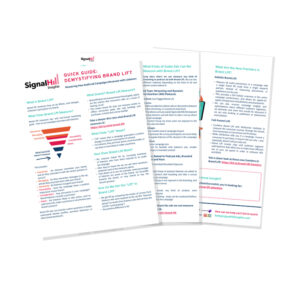As we’ve explored in this series of posts, brand lift is a powerful methodology for measuring and understanding how an ad campaign’s message is resonating with audiences. That goes to show the return on investment when your goals are in the upper-funnel, like awareness, favorability, and intent. Without a doubt, proving that effectiveness is valuable – but the value only multiplies when you can broaden and deepen the measurement, and then apply the learnings. Moreover, as we’ll discuss in a moment, we can even drive that effectiveness to the bottom of the funnel in brand lift for digital audio.
Holistic Measurement Across Publishers
Imagine you’re an ad buyer working on a new campaign to build awareness for our coffee flavored root beer. Because reach is important, it’s being placed across five publishers. The buy with three publishers is big enough that they’re willing to provide a brand lift study as added value. Two publishers work with the same research partner, and the third uses another, while the spend for the remaining publishers doesn’t qualify for any brand lift research. How do you make sense of this campaign’s overall performance?
Obviously you can compare the results of the three studies. With a little planning you can be sure the survey questionnaires are as similar as possible. Even so, the standard questions and methodology can vary a bit from partner to partner, complicating the analysis. But then you still have two publishers without studies.
A new frontier is to take a holistic approach. Imagine instead that, as the ad buyer, you chose a brand lift research partner to use across all publishers. You ensure that the same questionnaire and same methodology is used across the board, making for a closer apples-to-apples comparison of placements.
As we discussed in the last post in this series, the size and reach of a campaign is a factor in determining if using a live/tagged brand lift method is feasible. When all the placements across all publishers are aggregated together, it’s more likely to reach robust feasibility.
Uncovering Holistic Performance Insights
Then there’s also the opportunity to break down that performance by audience segments – such as gender, age or household income – as well as by publisher and sometimes even by individual placement or show. Here, we find that the root beer’s “energy” messaging (“spicy taste that gives you a lift”) was particularly appealing to men ages 25 – 34, driving a significant lift in agreement with that brand statement. There was also a significant lift in consideration among the segment.
At the same time, we see that the “coffee alternative” messaging (“when you don’t want just another iced latte”) achieved more traction with women 35 – 44, with a significant lift that statement, though smaller than the statement that appealed most to men. But there was only a directional lift in consideration.
Let’s say that one publisher is all sports content, with a very strong 80% male skew, while another focuses on wellness podcasts, having a 70% female skew.
If you were only judging results by publisher you might determine that the sports network performed better and that you should optimize by increasing your investment there next time, and reducing or eliminating your spend on the wellness network. However, looking at the holistic results by gender, you see that female sports listeners responded about the same as the female wellness listeners.
Better Optimizations in Brand Lift for Digital Audio
So, the story is less about the network and more about tailoring the message to specific audience demographics. Your optimization strategy then focuses on building on the “energy” message with male audiences, and doubling down on the “coffee alternative messaging” with female audiences. That allows you to broaden the reach of your effectiveness, where the less holistic approach might have led you to narrow it.
The picture can become even clearer by analyzing each of the ad creatives to see if a host’s endorsement made an additional impact, or if there were any differences in copy that resulted in performance variations. You might also examine if placement types – such as podcast-run-of-network or targeted streaming – or cadence had an effect.
Full-Funnel Measurement
Now the root beer brand is running a promotion offering free samples by mail. Web attribution is a great way to gauge the campaign’s impact on web landings and sign-ups for the samples (conversions). Combining attribution with brand lift gives you visibility through the entire funnel.
Just looking at attribution results, we see the sports network drove more web landings and conversions than the wellness network. That looks like an open-and-shut case. But, again looking at the brand lift results, we also see clearly that the messaging was more likely to move men to consider the drink (mid-funnel), which is likely why they were more likely to convert (lower-funnel). The brand lift showed us that optimizing the messaging is probably necessary for the female audience.
By using brand lift and attribution together in a full-funnel analysis we can then measure the next campaign to see if those optimizations really do increase attributed conversions with the female audiences.
Summing Up Brand Lift for Digital Audio
As a brand measures more campaigns the insights get deeper and more customized. You get a more detailed picture of how consumers respond to your products, creating a feedback loop that informs ever more effective optimizations. Because brand lift is your foundation you know what works and, critically, what doesn’t work. And can form strong hypotheses about why. In the end you’re empowered to drive more return on that ad spend. This is the future of brand lift in digital audio.
For those looking to grab a top-notch summary document around all things Brand Lift Study – look no further! Download our 3-page Quick Guide that helps demystify how brand lift works and how it can help you.





